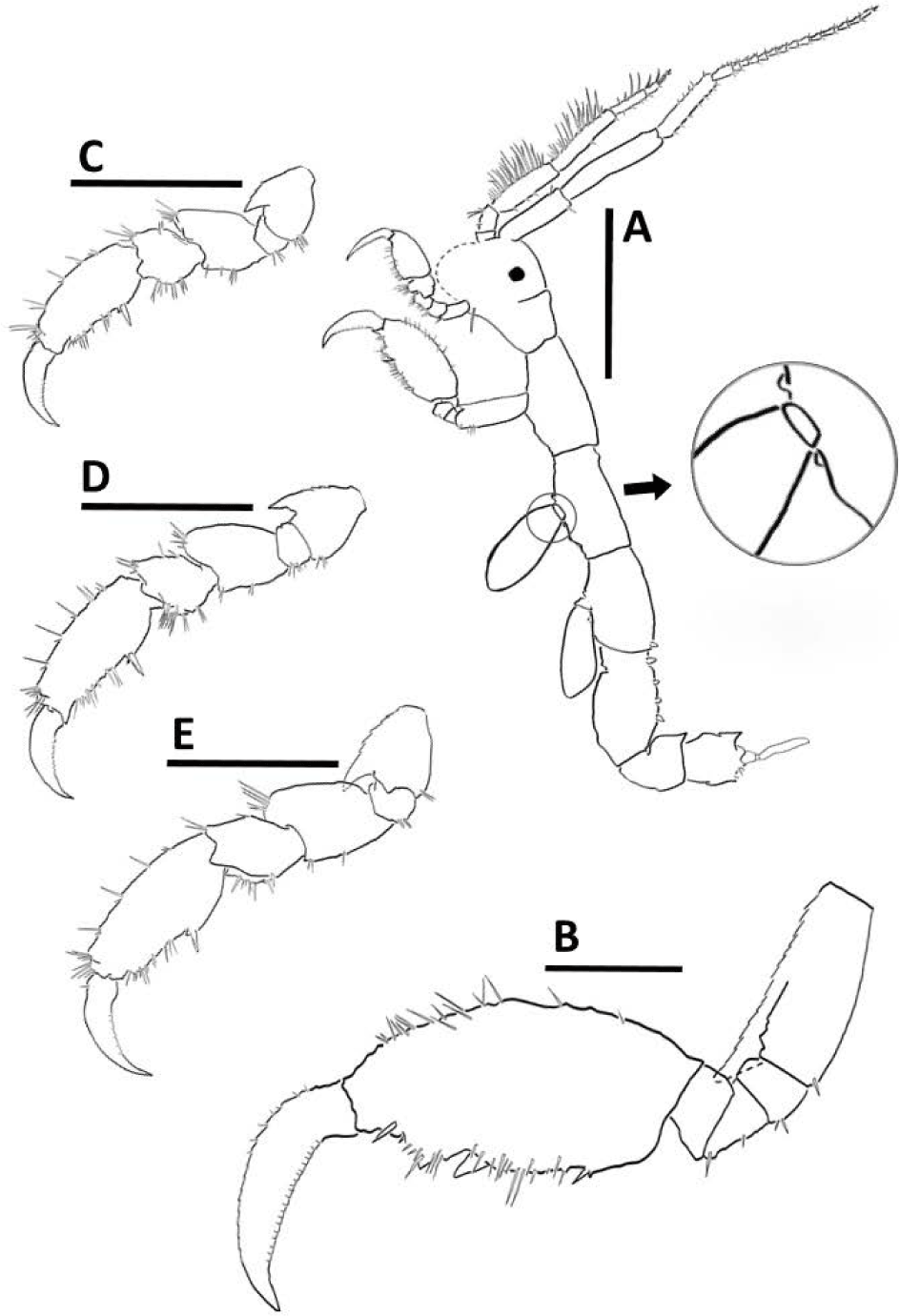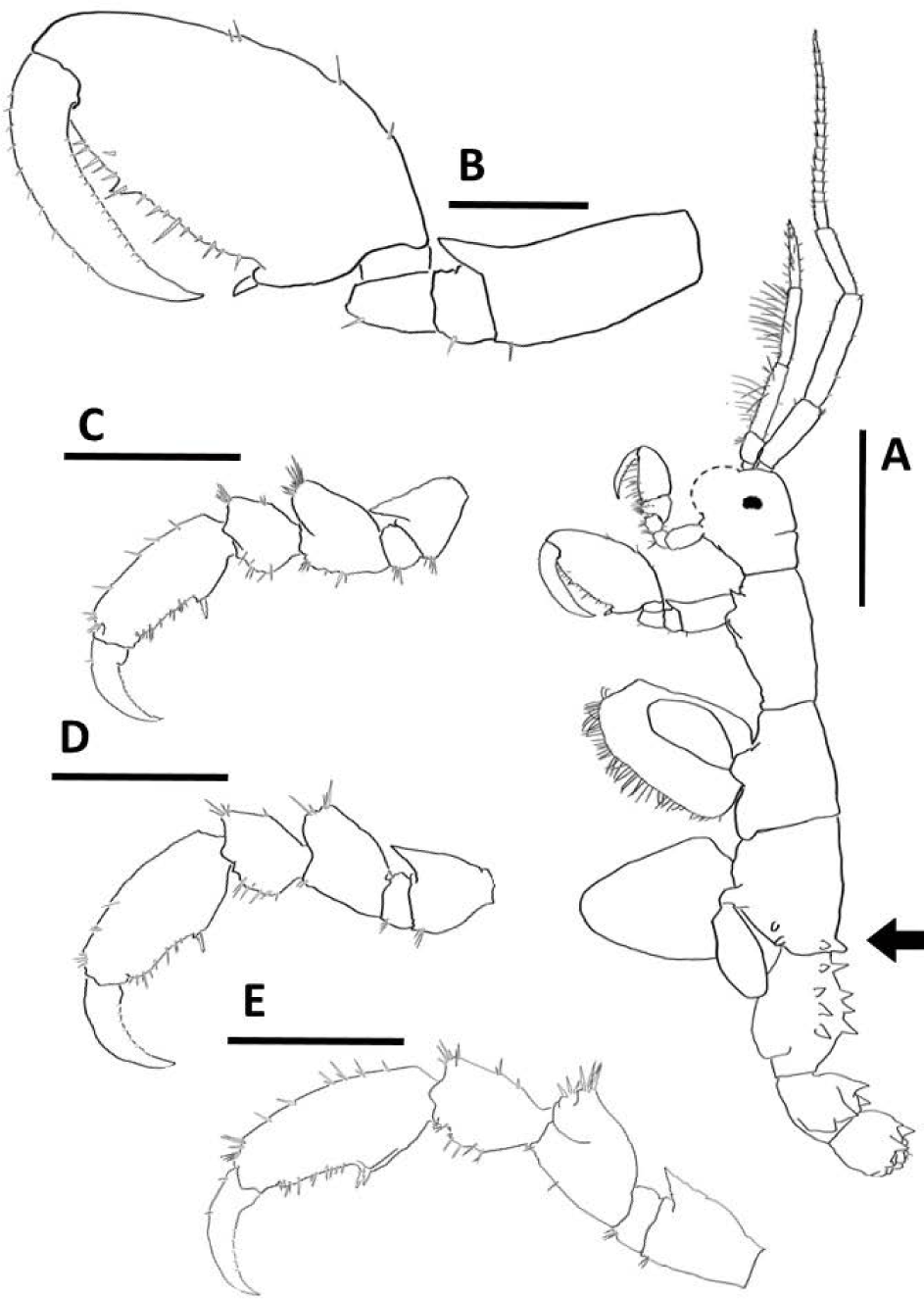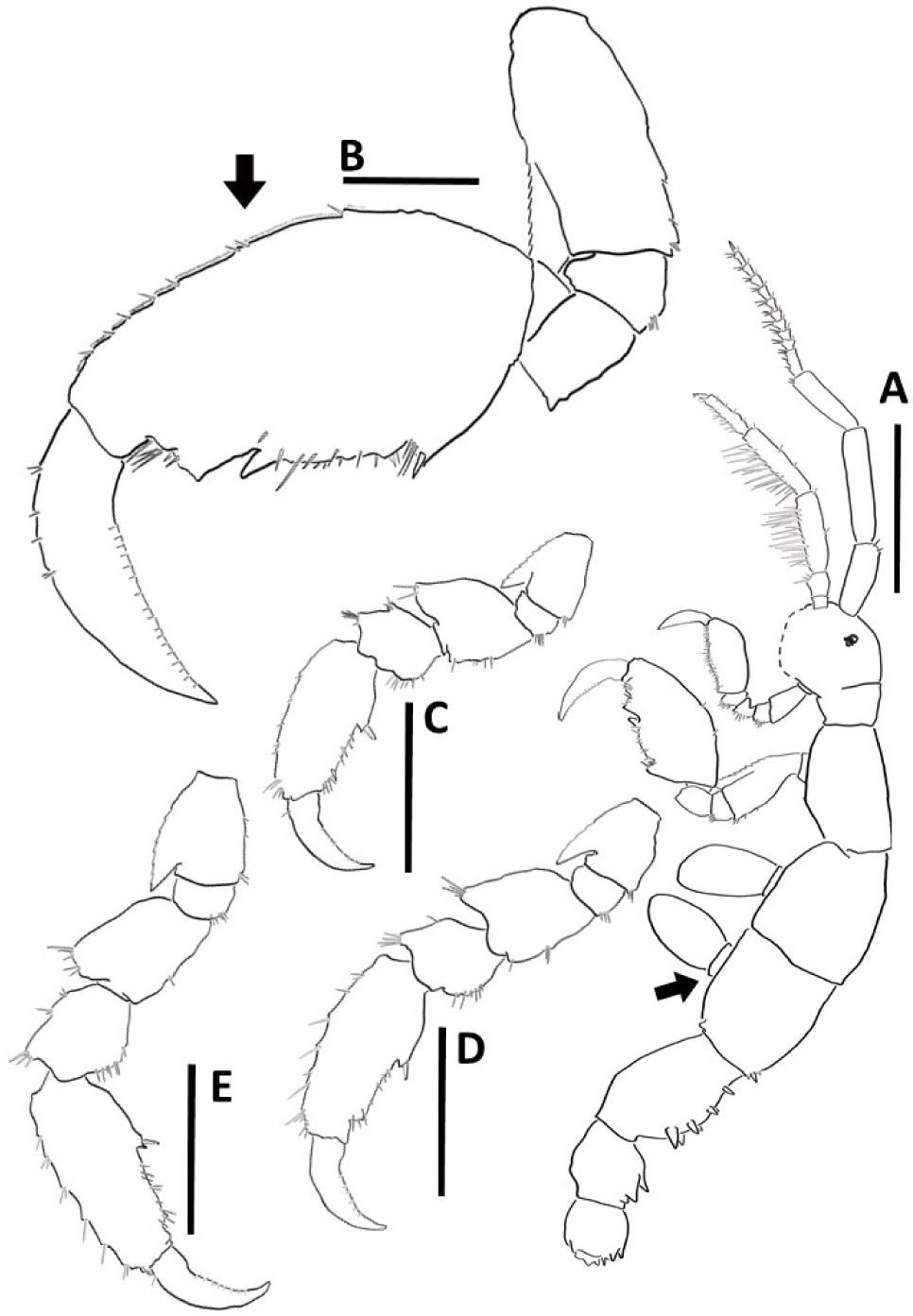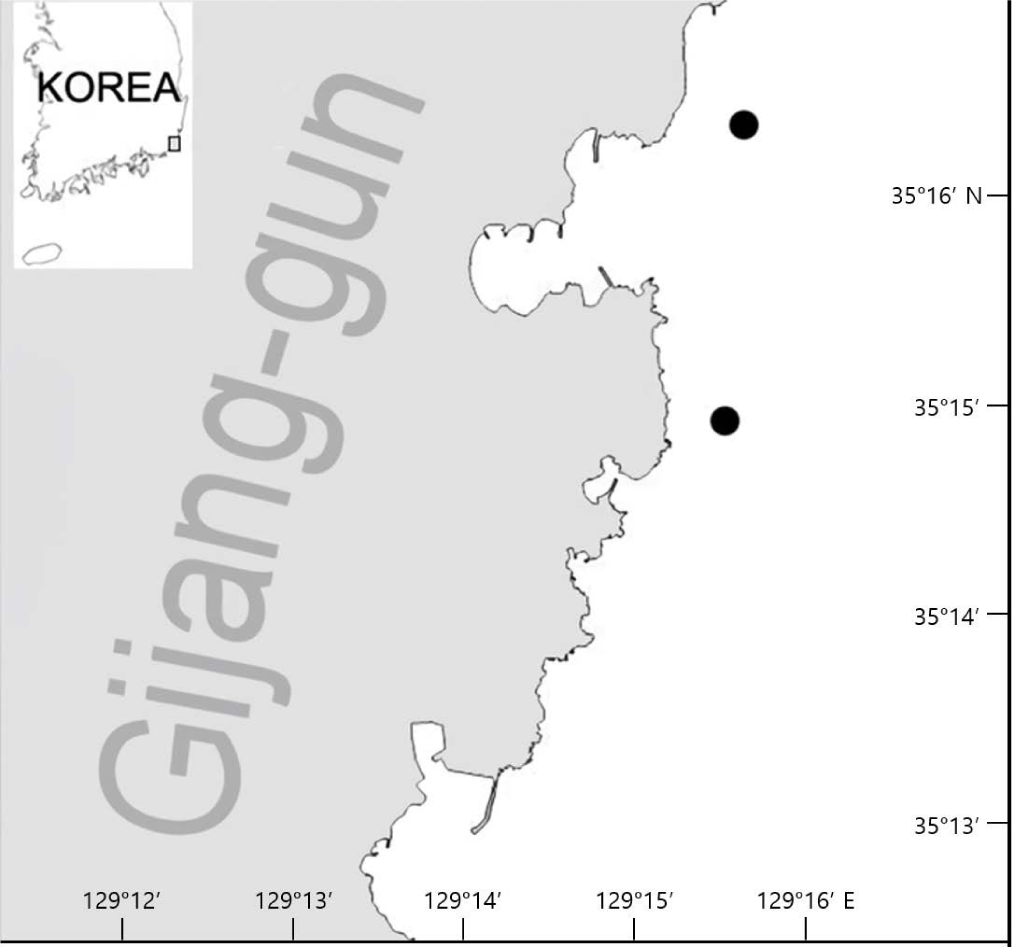Introduction
Seaweed beds provide substrates and foods for diverse invertebrates including amphipods (Yoo et al., 2007). Many seaweeds farms are located in the southeastern waters of Korea. Seaweed farms are anchored and structured by strong ropes. Ropes as well as seaweeds also provide habitats for diverse invertebrates. During a series of researches on invertebrates, tremendous number of caprellids have been found on the floating ropes in seaweed farms (Fisheries Resource Research Center of Gijang-County, 2019, 2020).
The family Caprellidae Leach, 1814 includes 108 genera. Among the genera, the largest genus Caprella Lamarck, 1801 comprises 209 species (WoRMS, 2023). 40 species in the family Caprellidae have been reported in Korean waters (NIBR, 2023).
Caprella ainoUtonomi, 1943 was firstly reported in Japanese waters (Utinomi, 1943). C. aino is hardly distinguishable from subadult Caprella muticaSchurin, 1935. Caprella cf aino was reported as a fouling organism on a fishing net in Tongyeong (Kim et al., 2021). Accordingly, similar species may be misidentified or regarded as C. aino.
This study reports firstly C. aino with illustrations. Also, this study provides differences between morphological characteristics between C. aino and C. mutica.
Materials and Methods
Attached organisms on the floating ropes were monthly collected from seaweed farms from the southeastern water (Gijang-county, Busan) of Korea from March 2021 to December 2021 (Fig. 1). The organisms were fixed in 70% ethyl alcohol in the sampling sites and transported to the laboratory. The attached organisms were classified and Caprella spp. were separated under the stereomicroscope (Olympus SZX2ILLK). C. aino and C. mutica were identified by Arimoto (1976), Heo et al. (2020) and Utinomi (1943). Gnathopod II and pereopods V to VII of adult C. aino and subadult C. mutica were dissected and mounted on depression slides. Drawings were made with the aid of a drawing tube. Then the illustrations were transformed into digital inking by Adobe Illustrator CC program.
Results and Discussion
Order Amphipoda Latreille, 1816
Family Caprellidae Leach, 1814
Genus Caprella Lamarck, 1801
(New Korean name: A-i-no-ba-da-dae-beol-rae).
Caprella ainoUtinomi, 1943 (Utinomi, 1943: 284-286, Fig. 2).
Caprella (Caprella) ainoArimoto, 1976 (Arimoto, 1976: 114-116, Figs. 61 and 62).
6♂♂, 8♀♀, Korea: Busan: Gijang-gun: Ilgwang-eup, 23 Jul 2021, 1♂, 3♀♀, Jangan-eup, 28 Oct 2021; 2♂♂, 2♀♀, Gijang-eup, 28 Oct 2021.
Adult male: Body (Fig. 2A) length about 6.16 mm. Smooth body surface, but with some dorsal tubercles of pereonites V to VII. Length ratio of pereonites I to VII, 0.31:1:0.95:0.86:0.84:0.32:0.42. Head rounded and smooth. Pereonite I short. Pereonite II longest. Little shorter pereonite III than pereonite II. Pereonite IV shorter than pereonite III. Pereonite V shorter than pereonite IV. Pereonite VI shortest. Pereonite VII little longer than pereonite VI. Pereonites III and IV of two small tubercles above of articulation of gills. Dorsal tubercles of two pairs on pereonite IV. Pereonite V of four dorsal tubercles. Pereonites VI and VII of one dorsal tubercle. Basis little shorter than half of pereonite II. Short ischium, merus, and carpus, slender propodus, falcate dactyl. Antenna I longer than half of body length. Flagellums 16-articulate with short setae. Peduncular 3-articulate, looking thicker than flagellum with sparse short setae. Antenna II setose, longer than half of antenna I. Flagellum 5 articulate with long setae. Peduncular 1 articulate with sparse short setae. Gills long and narrow. Gnathopod I small, attached to back of mouth part of head. Propodus looking quarter circle shaped. Gnathopod II (Fig. 2B) attached to little front part of pereonite II. Pereopod V (Fig. 2C) propodus with two proximal grasping spines, falcate dactyl. Length ratio of pereopod V 0.58:0.14:0.41:0.51:1:0.60. Pereopod VI (Fig. 2D) form similar to pereopod V, little longer than form similar to pereopod V. Length ratio of pereopod VI 0.49:0.23:0.46:0.52:1:0.63. Pereopod VII (Fig. 2E) form similar to pereopod V, little longer than pereopod VI. Length ratio of pereopod VII 0.45:0.24:0.49:0.53:1:0.59.

Adult female: Body (Fig. 3A) length about 7.01 mm. Smooth body surface, but with some dorsal tubercles of pereonites V to VII. Length ratio of pereonite I to VII 0.21:0.95:1:0.97:0.90:0.43:0.40. Head rounded and smooth. Pereonite I little shorter than half of head. Pereonite II short than pereonites III. Pereonite III longest. Pereonite IV little shorter than pereonite III. Pereonite V little shorter than pereonite IV. Pereonite VI shorter than pereonite V. Pereonite VII shortest. Pereonite IV with two dorsal tubercles. Pereonite V with four dorsal tubercles. Pereonites VI and VII with one dorsal tubercle. Antenna I longer than half of body length, flagellums slender and 16-articulated with short setae. Peduncular 3 articulated with sparse setae. Antenna II little shorter than peduncle of antenna I and setose, flagellums 5 articulated with long setae. Peduncule 1 articulate with sparse setae. Gills long and narrow. Gnathopod I small, attached to back of mouth part of head, propodus looking quarter circle shaped. Gnathopod II (Fig. 3B) attached to front part of pereonite II, basis little shorter than half of pereonite II, short ischium, merus, and carpus, slender propodus, falcate dactyl. Pereopod V (Fig. 3C) Propodus with two proximal grasping spines, falcate dactyl. Length ratio of pereopod V 0.46:0.19:0.49:0.47:1:0.62. Pereopod VI (Fig. 3D) form similar to pereopod V, little longer than pereopod V. Length ratio of pereopod VI 0.48:0.17:0.44:0.49:1:0.64. Pereopod VII (Fig. 3E) form similar to pereopod V, little longer than pereopod VI. Length ratio of pereopod VII 0.53:0.13:0.55:0.59:1:0.60.

Busan in Korea (the present study); Hokkaido and Bentenzima in Japan (Arimoto, 1976; Utinomi, 1943).
Caprella muticaSchurin, 1935 (Heo et al., 2020: 188-190, Fig. 4; Schurin, 1935: 112, 198, Fig. 1).

Caprella (Caprella) muticaArimoto, 1976 (Arimoto, 1976: 111-112, Fig. 59).
Caprella macho Platvoet, de Bruyne & Gmelig Meyling (Platvoet et al., 1995: 1-4, Fig. 1).
1♂, Korea: Busan: Gijang-gun: Jangan-eup, 28 Apr 2021; 5♂♂, 4♀♀, Ilgwang-eup, 10 Jun 2021; 1♂, Ilgwang-eup, 28 Oct 2021; 6♂♂, 2♀♀ Jangan-eup, 06 Dec 2021; 1♂, Ilgwang-eup, 06 Dec 2021.
Subadult: Body (Fig. 4A) length about 7.61 mm. Body covered very short setae of pereonite 2 and gnathopod 2, many dorsal tubercles of pereonites III to VII. Length ratio of pereonite I to VII 0.33:0.95:1:0.98:0.97:0.48:0.41. Head rounded and smooth. Pereonite I shortest. Pereonite II similar to basis of gnathopod II. Pereonite III longest. Pereonite IV little short than pereonite III. Pereonite V as long as pereonite IV. Pereonite VI almost half length of pereonite V. Pereonite VII short than pereonite VI. Pereonite IV with dorsal tubercles of two pairs. Pereonite V with four dorsal tubercles., Pereonites VI and VII with one dorsal tubercle. Antenna I longer than half of body length. Flagellums slender and 11 articulated with short setae. Peduncle 3 articulated with sparse setae. Antenna II little longer than peduncle of antenna I. Flagellums 4 articulated with long setae. Peduncle 1 articulate with sparse setae. Gills long and narrow. Gnathopod I small and attached to back of mouth part of head. Propodus rectangle, gnathopod II (Fig. 4B) attached to little front part of pereonite II, basis little short than pereonite II, short ischium, merus and carpus, propodus very short hairy, falcate dactyl. Pereopod V (Fig. 4C) propodus with short two proximal grasping spines, falcate dactyl, length ratio of pereopod V 0.54:0.14:0.51:0.47:1:0.64. Pereopod VI (Fig. 4D) form similar to pereopod V, little longer than pereopod V, length ratio of pereopod VI 0.44:0.19:0.54:0.45:1:0.61. Pereopod VII (Fig. 4E) form similar to pereopod V, little longer than pereopod VI, length ratio of pereopod VII 0.51:0.17:0.51:0.48:1:0.56.
Korea (Heo et al., 2020), North-East Asia, Europe, Pacific and Atlantic Ocean of North America, New Zealand (Ashton et al., 2007), South Africa (Peters & Robinson, 2017).
C. aino was firstly recorded in Japanese water. Characteristic of C. aino was accorded Arimoto (1976) and Utinomi (1943). C. aino and C. mutica are found in the same area. Adults of C. aino and C. mutica are easily distinguishable because adult C. mutica have pereonite II and gnathopod II covered with setae and pereonites III–VII with many tubercles, while C. aino bear pereonite II and gnathopod II without setae and two small tubercles of articulation of gills. However, adult C. aino and subadult C. mutica are hardly distinguishable because these have less developed tubercles on pereonite III and inconspicuous setae of pereonite II and gnathopod II. C. aino is distinguished from subadult C. mutica because adult C. aino have dorsal tubercles on pereonite IV, V, VI, VII unlike C. mutica. C. aino have some dorsal tubercle on pereonite IV–VII. These morphological characteristics given in the study help to tell adult C. aino apart subadult C. mutica.

